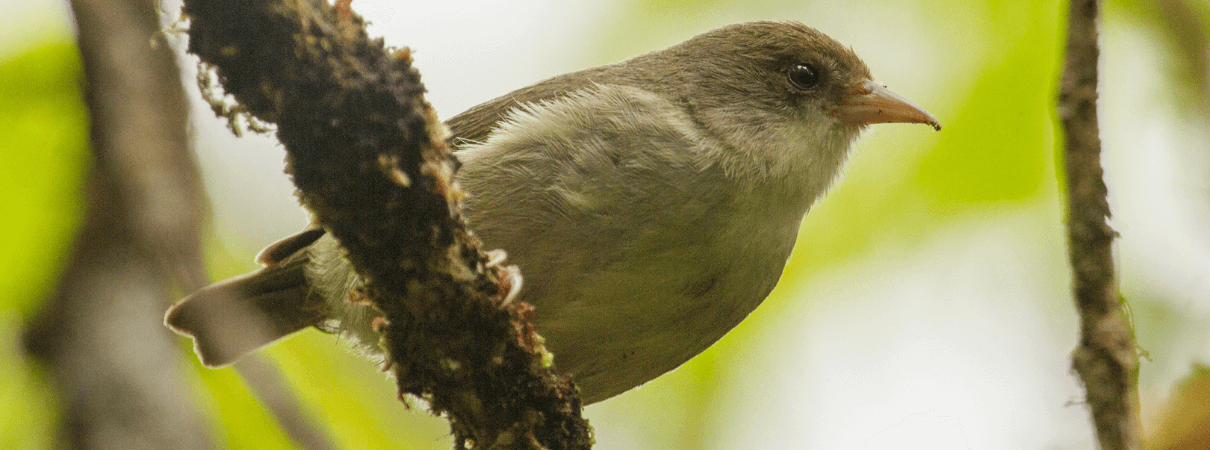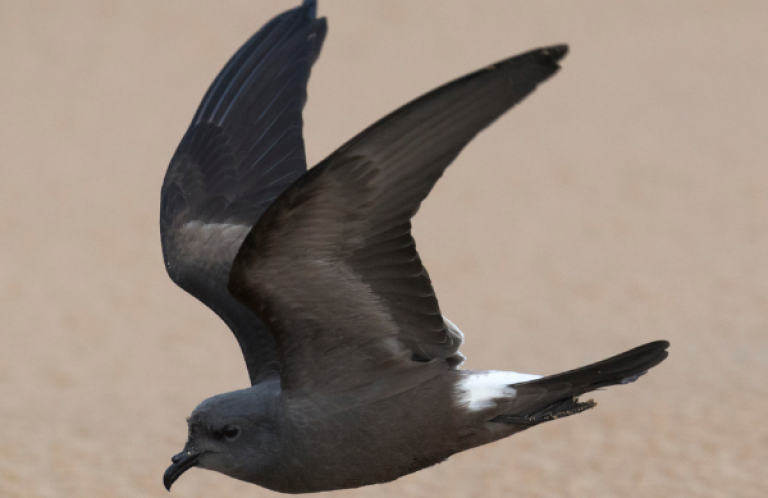As Extinctions Loom, Conservationists Race to Save Vanishing Hawaiian Honeycreepers

'Akikiki by Robby Kohley
(August 5, 2022) Several Hawaiian honeycreepers — found nowhere else on Earth — are on the brink of extinction. Their biggest threat comes from avian malaria, a mosquito-borne illness that was introduced to the islands by humans in the early 1900s. The situation is dire, but there is hope.
A technique that acts as a kind of mosquito birth control could soon be used to fight mosquito-borne diseases in Hawai‘i. This promising solution has already been used to reduce mosquito populations and control diseases in other parts of the world. Through a collaborative initiative called “Birds, Not Mosquitoes,” American Bird Conservancy (ABC) and partners* are working to bring mosquito birth control to Hawai‘i to defeat avian malaria and save the honeycreepers. It could be ready for early trial runs as soon as 2023.
About six million years ago, a rosefinch ancestor from mainland Asia found its way to the Hawaiian islands. Similar to the famously diverse finches of the Galápagos, this single species proliferated into at least 59 species of Hawaiian honeycreeper. Sadly, only one-third of those species are alive today.
The others were driven extinct by threats including habitat loss, the 19th century introduction of mosquitoes, and the 20th century arrival of avian malaria. Of the species that remain, at least four could go extinct within the next decade. Avian malaria represents the biggest existential threat to all four of them: the ‘Akikiki, Kiwikiu, ‘Akeke‘e, and ‘Ākohekohe. Climate change is exacerbating this threat.
“Rapid warming due to global climate change is allowing mosquitoes to invade the high mountain forests where these birds remain, and removing their last refuges,” said Chris Farmer, ABC's Hawai‘i Program Director. “We now have the ability to break the avian disease cycle in Hawai‘i. But the window to save these glorious birds is rapidly closing — we are the last generation that can, and therefore must, save these birds.”
Avian malaria is spread via an invasive mosquito called Culex quinquefasciatus. The mosquitoes arrived in 1826, and avian malaria arrived when people brought in non-native songbirds in the early 1900s. Honeycreepers — isolated on Hawai‘i for millions of years — have little to no natural immunity to the disease. In many cases, it takes just one bite from an infected mosquito to kill an individual bird.
“These magnificent birds are important to communities in Hawaiʻi as messengers and connectors between the seen and unseen realms,” said Lukanicole Zavas, ABC's Outreach Associate for Birds, Not Mosquitoes. “They are kinolau — body forms — of the Hawaiian gods, and the use of their feathers in the creation of the ʻahu ʻula (capes) for royalty represented the responsibility that the royalty had to the gods and to the people that they ruled over. Today, we have a responsibility to save these birds so that these connections persist into the future.”
Avian malaria could drive the ‘Akikiki extinct in the wild as soon as next year, according to a report from three agencies of the U.S. Department of the Interior. The ‘Akikiki's situation is dire, and urgent actions are underway to save this species, including captive breeding. If the wild population does vanish, mosquito control will be necessary before conservationists can reintroduce the species to the wild — the ultimate goal of any captive program. Swift action is also necessary to save the other three species at risk of extinction within the decade — and all the other honeycreepers that are on a similar extinction trajectory — from the ‘Akikiki's fate.
Birds, Not Mosquitoes has identified mosquito birth control as the best hope to save these species. The method involves introducing an incompatible strain of a common, naturally occuring bacteria called Wolbachia into male (non-biting) mosquitoes. This makes them unable to successfully reproduce with wild females that carry a different Wolbachia strain.
The “Wolbachia-incompatible mosquito” method is already used around the world to combat diseases that pose a risk to human health, such as dengue. It has even been approved to control mosquito populations in other states. The next step is developing the technology for the mosquito species that carries avian malaria in Hawai‘i, and getting the permits to release the Wolbachia-incompatible mosquitoes before more honeycreepers go extinct.
“We have the pieces of the solution and dedicated people who can successfully combine and implement them, and we are now furiously racing against the extinction clock to develop and deploy them,” Farmer said. “But we can do it.”
Luckily, this year Birds, Not Mosquitoes has hit several important milestones on the path to that goal. ABC and The Nature Conservancy have partnered to support development of the Wolbachia-incompatible C. quinquefasciatus mosquito. The partnership will soon move on to producing the mosquitoes for release on the Hawaiian Islands, pending approval by state and federal regulatory agencies. In June, Hawai‘i's Department of Agriculture voted unanimously to allow the import of Wolbachia mosquitoes into Hawai‘i — a major step forward in that process.
On the current timeline, Birds, Not Mosquitoes hopes to do small-scale field tests in 2023, and targeted releases of Wolbachia-incompatible mosquitoes to the most critical habitats in 2024. If permits continue to be approved, releases could expand to several Hawaiian islands by 2025. The timeline might seem ambitious, but the unique birds of Hawaiʻi are running out of time. Honeycreeper populations are dropping by the hundreds each year, and biologists must eradicate more than 90 percent of the C. quinquefasciatus mosquitoes to break the disease cycle.
*Birds, Not Mosquitoes partners:
American Bird Conservancy; Coordinating Group on Alien Pest Species; Hawaiʻi Department of Agriculture; Hawaiʻi Department of Health; Hawaiʻi Department of Land and Natural Resources; Hawaiʻi Invasive Species Council; Island Conservation; Kahālāwai Consulting; Kauaʻi Forest Bird Recovery Project; Maui Forest Bird Recovery Project; Michigan State University; MosquitoMate; National Park Service; Office of Hawaiian Native Relations; Pacific Rim Conservation; The Nature Conservancy; University of California; University of Hawaiʻi; U.S. Fish and Wildlife Service; U.S. Geological Survey; Verily Life Sciences
###
American Bird Conservancy is a nonprofit organization dedicated to conserving wild birds and their habitats throughout the Americas. With an emphasis on achieving results and working in partnership, we take on the greatest problems facing birds today, innovating and building on rapid advancements in science to halt extinctions, protect habitats, eliminate threats, and build capacity for bird conservation. Find us on abcbirds.org, Facebook, Instagram, and Twitter (@ABCbirds).
Media Contact: Jordan Rutter, Director of Public Relations| jerutter@abcbirds.org | @JERutter


















































